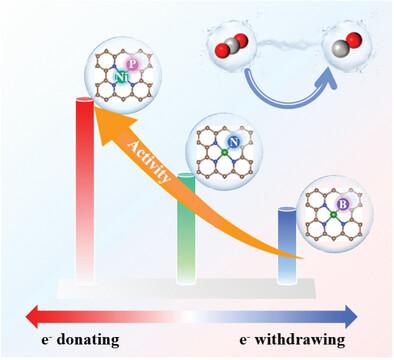Modulating Electronic Density of Single-Atom Ni Center by Heteroatoms for Efficient CO2 Electroreduction
IF 13
2区 材料科学
Q1 CHEMISTRY, MULTIDISCIPLINARY
引用次数: 0
Abstract
Single-atom catalysts (SACs) with unique geometric and electronic configurations have triggered great interest in many important reactions. However, controllably modulating the electronic structure of metal centers to enhance catalytic performance remains a challenge. Here, the electronic structure of Ni centers over Ni1-NC SACs by introducing electron-rich phosphorus or electron-deficient boron for electrochemical CO2 reduction (CO2RR) is systematically tailored. It is found that the Ni1-PNC with Ni1-N3P site exhibits superior performance with a current density of 14.6 mA cm−2 and a Faradaic efficiency of 90.6% at −0.8 V versus RHE for CO production, far exceeding Ni1-NC and Ni1-BNC SACs. Detailed characterizations and theoretical calculations reveal a linear relationship between the valence state of Ni species and the CO2RR performance. The incorporation of P species facilitates the electronic localization around the Ni1 center, significantly promoting the adsorption of CO2 and the formation of key *COOH intermediate to enhance CO2RR. This work provides a feasible approach to quantitatively manipulate the electronic structure of single-atom metal sites and to rationally design highly efficient catalysts for boosted performance.

求助全文
约1分钟内获得全文
求助全文
来源期刊

Small
工程技术-材料科学:综合
CiteScore
17.70
自引率
3.80%
发文量
1830
审稿时长
2.1 months
期刊介绍:
Small serves as an exceptional platform for both experimental and theoretical studies in fundamental and applied interdisciplinary research at the nano- and microscale. The journal offers a compelling mix of peer-reviewed Research Articles, Reviews, Perspectives, and Comments.
With a remarkable 2022 Journal Impact Factor of 13.3 (Journal Citation Reports from Clarivate Analytics, 2023), Small remains among the top multidisciplinary journals, covering a wide range of topics at the interface of materials science, chemistry, physics, engineering, medicine, and biology.
Small's readership includes biochemists, biologists, biomedical scientists, chemists, engineers, information technologists, materials scientists, physicists, and theoreticians alike.
 求助内容:
求助内容: 应助结果提醒方式:
应助结果提醒方式:


